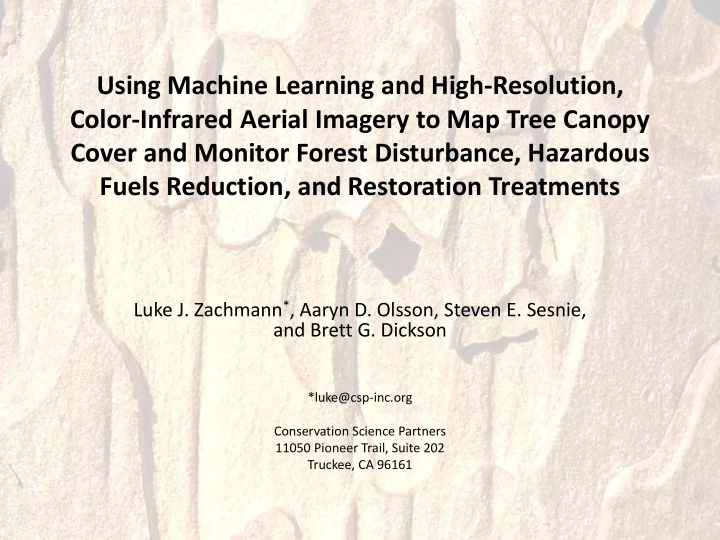

Using Machine Learning and High-Resolution, Color-Infrared Aerial Imagery to Map Tree Canopy Cover and Monitor Forest Disturbance, Hazardous Fuels Reduction, and Restoration Treatments Luke J. Zachmann * , Aaryn D. Olsson, Steven E. Sesnie, and Brett G. Dickson *luke@csp-inc.org Conservation Science Partners 11050 Pioneer Trail, Suite 202 Truckee, CA 96161
2 Objectives 1) Develop techniques for rapid and cost- effective assessment of tree canopy cover at broad spatial scales using high-resolution, freely available imagery 2) Develop methods to track changes in tree canopy cover in forest treatment areas over time
3 Study area - ½M acres - 305,000 acres of PIPO
4
5 Canopy pixel “Other” pixel NAIP (4 bands) NDVI (1 band) NDVI/NIR (1 band) Texture (1 band) Cover R G B NIR NDVI NDVI/NIR other 72 86 81 108 1429 13.23 canopy 63 75 76 116 2083 17.96
6 Support vector machines (SVMs): a two-dimensional example • SVMs have a unique method of fitting separating planes between different classes of data Canopy Shadow
7 canopy other shadow
8 The error matrix: overall accuracy REFERENCE Canopy Other Shadow Canopy 1004 4 44 PREDICTED Other 8 5921 11 Shadow 30 4 824 Overall accuracy is the sum of the major diagonal (i.e., correctly classified pixels) divided by the total number of sample units in the entire error matrix: 1004 + 5921 + 824 = 98.7% 7850
9 Stand-level canopy cover 100% 0%
10 NAIP 2007 Stand boundaries
11 NAIP 2010 Stand boundaries
12 Classification results 2007 canopy other shadow
13 Classification results 2010 canopy other shadow
14 Classification results 2010 canopy other shadow
15 Problem: canopy cover differs even in undisturbed areas 2007 2010 (52%) (56%) canopy canopy other other shadow shadow
16 Undisturbed areas
17 Why do such differences exist? • Camera types • Time of image acquisition and phenology • Image alignment • Illumination and viewing geometries (e.g., bidirectional reflectance and radial distortion)
18 Spatial shadow affects
19 Temporal shadow affects
20 What do we do? 1) Geometrically correct 2007 predictions using 2010 as the reference 2) Come up with a way to control for differences in image quality using a canopy adjustment factor (CAF): 𝑓𝑚𝑓𝑤𝑏𝑢𝑗𝑝𝑜 𝑡𝑚𝑝𝑞𝑓 𝐷 2007 −𝐷 2010 𝝔 = 𝑏𝑡𝑞𝑓𝑑𝑢 𝐷 2007 +𝐷 2010 = 𝑔 𝑞𝑝𝑡𝑗𝑢𝑗𝑝𝑜 𝑑𝑚𝑏𝑡𝑡 𝑞𝑠𝑝𝑞𝑝𝑠𝑢𝑗𝑝𝑜𝑡
21 CAF map C 200 7 > 𝐷 2010 C 2007 = 𝐷 2010 C 2007 < 𝐷 2010
22 Undisturbed areas 𝟐 + 𝝔 𝑫 𝟑𝟏𝟐𝟏 𝟐 − 𝝔
23 Absolute tree canopy cover change Marginal gain No change 45% loss
24 Conclusions • These data are useful in establishing baseline conditions and monitoring resource trends at broad spatial scales and can be developed quickly and relatively cheaply • Errors associated with image characteristics can be corrected using a canopy adjustment factor • These data could be used in many applications, including comparing conditions in “relic” stands to conditions elsewhere, and could also be used in conjunction with other data to help guide management decisions
25 Acknowledgments • Grand Canyon Trust • Co-authors • Questions?
26 Supplementary slides
27 Image data collection Leica ADS40 Airborne Intergraph Z/I Imaging Digital Digital Sensor (2007) Mapping Camera (2010) • Pushbroom type • Framing camera sensor (line by line) (patch by patch) • Potential problems: • Potential problems: low sensitivity multispectral risk of overexposure channels
Recommend
More recommend